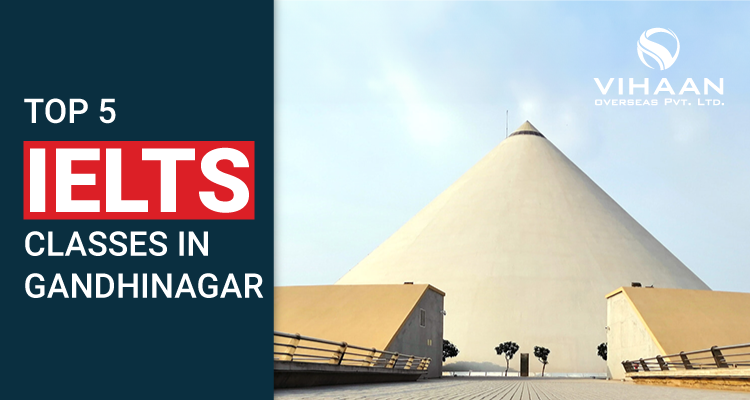
How to Score 6+ Bands in IELTS: Tips from Experts
April 29, 2025
Top Master’s Courses to study in UK 2025
May 14, 2025Introduction: IELTS vs PTE for Studying Abroad
Deciding which English proficiency test to take is one of the first major decisions in your study abroad journey. With numerous options available, IELTS (International English Language Testing System) and PTE (Pearson Test of English) stand out as popular choices among international students. But which one should you choose? This comprehensive guide will help you understand the key differences between these two exams and decide which one might better suit your study abroad aspirations.
At Vihaan Overseas, we've guided thousands of students through this crucial decision. As certified experts in both IELTS and PTE preparation, we understand the unique features of each test and how they align with different student profiles and destinations.
IELTS vs PTE: A Quick Comparison Table
Before diving into the details, here's a quick overview of how these two leading English proficiency tests compare:
| Feature | IELTS | PTE Academic |
|---|---|---|
| Test Format | Both paper-based and computer-based options | Fully computer-based |
| Test Duration | 2 hours 45 minutes | 2 hours |
| Sections | Reading, Writing, Listening, Speaking | Reading, Writing, Listening, Speaking |
| Speaking Component | Face-to-face interview with an examiner | Computer-based (speaking to a microphone) |
| Results Waiting Time | Your results will be available after 7 calendar days from the test date. | Typically, 48 hours |
| Scoring System | Band scores (0-9) | Global Scale of English (10-90) |
| Test Fee | Approximately $180-240 USD (varies by country) | Approximately $180-210 USD (varies by country) |
| Acceptance | Widely accepted globally | Growing acceptance, especially strong in Australia |
Note: Fees and processing times may change based on location and are subject to change.
What is IELTS? The Trusted Traditional Test What is IELTS?
IELTS has been the gold standard in English language testing since 1989. Co-owned by the British Council, IDP: IELTS Australia, and Cambridge Assessment English, this test has earned a reputation for reliability and widespread acceptance.
Types of IELTS Tests
There are two main versions of the IELTS test:
1. IELTS Academic: Designed for students seeking admission to undergraduate and postgraduate programs
2. IELTS General Training: Focused on everyday English skills for immigration purposes
For study abroad purposes, most students need to take the IELTS Academic test.
IELTS on Paper: The Traditional Option
IELTS on Paper is the classic method for taking the test. This format is widely available and allows test-takers to complete their Listening, Reading, and Writing sections on paper, while the Speaking test remains face-to-face with a certified examiner.
Test Format and Structure
IELTS examines four language skills:
Listening (30 minutes + 10 minutes transfer time)
- 4 recorded sections with increasing difficulty
- 40 questions in total
- Various question types including multiple choice, matching, and sentence completion
Reading (60 minutes)
- 3 long passages with 40 questions
- Academic texts from books, journals, and magazines
- Question types include multiple choice, identifying information, and matching headings
Writing (60 minutes)
- Task 1: Describe visual information (graph, table, chart, or diagram) in 150+ words
- Task 2: Write an essay responding to an argument in 250+ words
Speaking (11-14 minutes)
- Face-to-face interview with a certified examiner
- Three parts: introduction, individual long turn, and two-way discussion
- Assessed on fluency, vocabulary, grammar, and pronunciation
Understanding PTE Academic: The Modern Digital Test
What is PTE?
Launched in 2009 by Pearson PLC, PTE Academic is a newer but rapidly growing English proficiency test. It's fully computer-based and uses AI scoring technology alongside human raters.
Test Format and Structure
Like IELTS, PTE Academic also tests four language skills, but with a different structure:
Speaking & Writing (54-67 minutes)
- Personal introduction
- Read aloud
- Repeat sentence
- Describe image
- Re-tell lecture
- Answer short question
- Summarize written text
- Write essay
Reading (29-30 minutes)
- Multiple-choice questions
- Re-order paragraphs
- Fill in the blanks
- Reading & writing: Fill in the blanks
Listening (30-43 minutes)
- Summarize spoken text
- Multiple-choice questions
- Fill in the blanks
- Highlight correct summary
- Multiple-choice questions with single answers
- Select missing word
- Highlight incorrect words
- Write from dictation
The PTE Academic test is fully computer-based, including the speaking section where you speak into a microphone rather than to a human examiner.
IELTS vs PTE: Key Differences You Need to Know
1. Test Format and Environment
IELTS Academic:
- Provides both paper-based and computer-delivered options
- Speaking test involves a face-to-face interview with a human examiner
- Test components can be taken on different days
- More traditional testing environment
PTE Academic:
- Fully computer-based test
- All sections completed in one sitting
- Speaking test conducted via computer microphone
- Testing environment can feel more impersonal but is consistent
Student Perspective: "I chose IELTS because I feel more comfortable speaking to a real person rather than a computer. The face-to-face interaction helped me demonstrate my English skills more naturally." - Rahul, MSc student in Canada
2. Scoring System and Results
IELTS Academic:
- Band scores range from 0-9 (including half bands like 6.5)
- Manual scoring by trained examiners
- The results will be available within 7 calendar days after the test date.
- Score validity of 2 years
PTE Academic:
- Automated scoring through AI algorithms
- Results typically available within 48 hours
- Score validity of 2 years
Student Perspective: "The quick results from PTE were crucial for my application deadlines. I got my scores in just 2 days and could complete my university application on time." - Ananya, Engineering student in Australia
3. Test Difficulty and Pass Rates
Many students wonder, "Is PTE easier than IELTS?" There's no definitive answer, as it depends on: </p.
- Your individual strengths and weaknesses
- Your comfort with technology
- Your experience with different accents
- Your test-taking style
Common Perceptions::
IELTS may be easier for those who:
- Prefer human interaction
- Are comfortable with traditional test formats
- Excel in descriptive writing
- Have stronger handwriting skills
PTE may be easier for those who:
- Are tech-savvy
- Prefer objective scoring
- Feel anxious speaking to examiners
- Can process information quickly
Global Recognition: Where Are IELTS and PTE Accepted?
IELTS Acceptance
IELTS is widely recognized across:
- Over 11,000 organizations in more than 140 countries
- Virtually all universities in the UK, Australia, and New Zealand
- Most universities in Canada and the USA
- Immigration authorities in Australia, Canada, New Zealand, and the UK
PTE Academic Acceptance
PTE has grown in acceptance:
- Recognized by thousands of academic programs worldwide
- All Australian and New Zealand universities
- Majority of UK universities
- Growing number of North American institutions
- Australian and New Zealand immigration authorities
Pro Tip: Always check the specific requirements of your target universities and visa applications before deciding which test to take.
How to Choose Between IELTS and PTE: A Decision Guide
Consider Your Strengths
Choose IELTS if you:
- Prefer human interaction in speaking tests
- Have good handwriting
- Process information at a moderate pace
- Prefer traditional test formats
- Are planning to study in the UK or Canada primarily
Choose PTE if you:
- Are comfortable with computer-based testing
- Prefer speaking to a microphone rather than a person
- Want faster results
- Like integrated tasks
- Are planning to study in Australia
Consider Your Target Score
If you need a high score equivalent, research suggests:
| IELTS Band | Approximate PTE Score |
|---|---|
| 5.0 | 36-41 |
| 5.5 | 42-49 |
| 6.0 | 50-57 |
| 6.5 | 58-64 |
| 7.0 | 65-72 |
| 7.5 | 73-78 |
| 8.0 | 79-82 |
| 8.5 | 83-85 |
| 9.0 | 86+ |
Note: This is an approximate conversion and requirements may vary by institution.
Preparation Strategies for IELTS and PTE
Top IELTS Preparation Tips for Study Abroad Success
1. Familiarize yourself with the format
- Take practice tests to understand timing and question types
- Learn the assessment criteria for each section
2. Improve your handwriting (for paper-based test)
- Practice writing clearly and quickly
- Work on your spelling and grammar
3. Develop speaking confidence
- Practice speaking on various topics
- Record yourself and identify areas for improvement
- Get comfortable with the interview format
4. Reading strategies
- Practice skimming and scanning techniques
- Build academic vocabulary
- Improve reading speed while maintaining comprehension
PTE Exam Preparation Strategies That Work
1. Master the technology
- Get comfortable with the computer interface
- Practice speaking clearly into a microphone
- Learn to manage time effectively on a computer
2. Understand the scoring algorithm
- Focus on content rather than accent
- Learn what the AI scoring system prioritizes
- Practice integrated tasks that test multiple skills
3. Build quick response skills
- Practice responding promptly to questions
- Develop skills for describing images quickly
- Work on summarizing information efficiently
4. Use official practice materials
- Access the official scored practice tests
- Understand the types of questions that appear frequently
Expert Tip from Vihaan Overseas: "We've found that students who take at least 5 full-length practice tests under timed conditions see significant improvement in their scores, regardless of which test they choose."
IELTS vs PTE: In-Depth Section-by-Section Comparison
Listening Section Comparison
| Aspect | IELTS Academic | PTE Academic |
|---|---|---|
| Duration | 30 minutes + 10 minutes transfer time | 30–43 minutes |
| Question Types | Multiple choice, matching, sentence completion, etc. | Multiple choice, fill in the blanks, highlight correct summary, etc. |
| Audio Sources | Conversations, monologues, various accents | Academic lectures, conversations, various accents |
| Note-taking | Allowed during audio | Allowed during specific parts |
| Replay Option | No replay (audio played once) | Some items have replay option |
Reading Section Comparison
| Aspect | IELTS Academic | PTE Academic |
|---|---|---|
| Duration | 60 minutes | 29–30 minutes |
| Text Types | Long academic passages | Shorter texts, often incomplete |
| Question Types | Multiple choice, matching headings, TRUE/FALSE/NOT GIVEN, etc. | Multiple choice, re-order paragraphs, fill in the blanks |
| Number of Questions | 40 questions | Varies, typically 15–20 items |
| Time Pressure | Moderate to high | Very high |
Writing Section Comparison
| Aspect | IELTS Academic | PTE Academic |
|---|---|---|
| Tasks |
Task 1: Describe visual data Task 2: Essay |
Summarize written text Write essay |
| Duration | 60 minutes | Part of 54–67 minutes for Speaking & Writing |
| Word Count |
Task 1: 150+ words Task 2: 250+ words |
Summary: 50–70 words Essay: 200–300 words |
| Assessment | Human examiner evaluation | AI algorithm + human verification |
| Key Skills Tested | Description, analysis, argumentation | Summarization, argumentation |
Speaking Section Comparison
| Aspect | IELTS Academic | PTE Academic |
|---|---|---|
| Format | Face-to-face interview | Speaking into a microphone |
| Duration | 11–14 minutes | Part of 54–67 minutes for Speaking & Writing |
| Tasks | Introduction, long turn, discussion | Read aloud, repeat sentence, describe image, etc. |
| Assessment | Human examiner evaluation | AI algorithm + human verification |
| Environment | Private room with examiner | Test center with other test-takers |
IELTS Fees, PTE Fees and Value Analysis
Test Fees Comparison
Both tests have similar fee structures, though prices vary by country:
- IELTS: Approximately $180-240 USD
- PTE Academic: Approximately $180-210 USD
Value Considerations
IELTS Value Advantages
- Widely accepted globally
- Option for paper-based testing
- Human interaction might benefit some test-takers
PTE Value Advantages
- Faster results (typically within 48 hours)
- More flexible test dates and times
- Free score reports to unlimited institutions
Financial Tip: "At Vihaan Overseas, we help students access preparation materials and resources that can save thousands in retake fees. Proper preparation is the best investment you can make in your testing journey."
Strategic Decision Making: Choosing What's Right for You
When making your final decision, consider these factors:
1. Your Destination Country
- Australia & New Zealand: Both tests widely accepted, PTE popular
- UK: IELTS traditionally preferred, but PTE gaining ground
- Canada: IELTS more widely recognized
- USA: Both accepted at many institutions, check specific requirements
2. Your Timeline
- Need results quickly? PTE typically returns results in 48 hours
- Planning well in advance? Either test works
3. Your Test-Taking Style
- Prefer human interaction? IELTS speaking may suit you better
- Comfortable with technology? PTE's computer-based format might be ideal
4. Your English Strengths
- Strong in conversation? IELTS might showcase this better
- Good at quick responses and integrated tasks? PTE might highlight these skills
Decision Framework: Make a pros and cons list based on your specific situation, weighing factors like destination country, time constraints, and personal preferences.
Choosing the Right Test: Final Thoughts from Vihaan Overseas
At Vihaan Overseas, we use a personalized assessment approach to help students choose between IELTS and PTE:
1. Skills Assessment: We evaluate your current English proficiency and learning style
2. Goals Analysis: We consider your target destinations and institutions
3. Timeline Review: We factor in your application deadlines
4. Practice Test Comparison: We often recommend taking practice versions of both tests
5. Custom Recommendation: Based on all factors, we provide a personalized recommendation
Remember, the "best" test is simply the one that allows you to showcase your English proficiency most effectively and meet your specific study abroad requirements.
Conclusion: Take the Next Step Toward Studying Abroad
Choosing between IELTS and PTE is an important decision, but not one to stress over excessively. Both are internationally recognized English proficiency tests that can open doors to global education opportunities.
The key is to making an informed choice based on your personal strengths, destination requirements, and preparation timeline. Whichever test you choose, dedicated preparation is the real key to success.
At Vihaan Overseas, we're dedicated to supporting students throughout their study abroad journey, from choosing the right English proficiency test to preparing thoroughly and achieving their target scores. Our team of IDP-certified faculty for IELTS and PTE preparation is committed to helping you succeed.
Ready to take the next step in your study abroad journey? Contact Vihaan Overseas today for personalized guidance on your English proficiency testing strategy complete preparation support.
Frequently Asked Questions
The main differences include:/p>
- Test delivery (IELTS offers paper-based options; PTE is fully computer-based)
- Speaking format (IELTS uses human examiners; PTE uses computer recording)
- Scoring system (IELTS uses bands 0-9; PTE uses points 10-90)
- Results timeframe (IELTS results typically take 7 days; PTE typically takes 48 hours)
- Test structure (PTE has more integrated tasks testing multiple skills simultaneously)
A "good" score depends on your goals:
For University Admission:
- IELTS: Most universities require 6.0-7.0 overall
- PTE: Equivalent scores would be 50-65 points
For Competitive Programs (Medicine, Law, etc.):
- IELTS: Often 7.0+ overall with minimum 7.0 in each section
- PTE: 65+ overall with similar section requirements
For PR Applications:
- Requirements vary by country and program
- For Australian PR, typically IELTS 7.0+ or PTE 65+ for maximum points
Neither is fundamentally "better" for PR purposes. The choice depends on:
- Which country you're applying to
- Your English proficiency profile
- Which test format you perform better in
- Current immigration policies
For Australian PR, both tests are well-established. For Canadian PR, IELTS has been the traditional choice, but PTE is gaining acceptance.

















